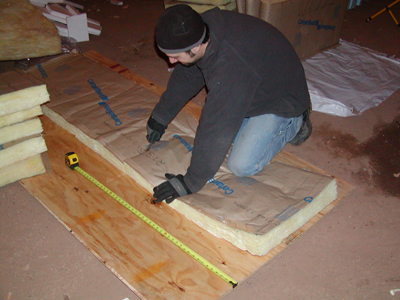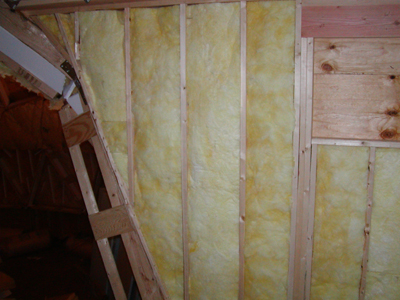Because this is a Natural Spaces Domes home, we are using the Natural Spaces Domes Super-Wal construction with very thick walls which we filled with insulation. For the Bear Creek Dome we chose to use 18″ thick walls based on our needs here in Minnesota. In colder climates you may want the thicker Natural Spaces Domes Super-Wal. In warmer climates a 15″ wall might be more appropriate. There are other climate related issues and Natural Spaces Domes will help you decide what is best for your “neck of the woods.”
While we have test spots in the dome where we are using cotton and wool insulation, we decided to use fiber glass insulation for the rest of the dome. The use of Knauf Brand insulation for health safety has improved because the formaldehyde is no longer used in its productions. Also fiber glass is made from recycled glass so it has that benefit to the environment. We would suggest wearing a mask as you work with any insulation product. Inhalation of foreign products into your lungs is not good no matter what it is. That includes the installation of all insulation products.
Obviously, insulation keeps your home warmer in the winter and cooler in the summer thereby creating less need for energy. The “R” value of our Bear Creek Dome is 55. Investment in good insulating systems will provide you with great costs savings over the years. The cost of heating and cooling a Natural Spaces Dome is approximately 1/3 to 1/5 the cost of a conventional home of the same size.
Thurs. 3:15pm — Now we need to get this dome insulated. We will be using 2 layers of 8″ insulation. We normally use 6′ and 8′ wide rolls of insulation but with the shortages all we could get was 4′ wide rolls. First step is to take the interior panel pattern, lay it on top of the insulation and cut a slightly larger size. This insulation is a special industrial grade and is very stiff. As you can see, it stands up by itself on the narrow 8″ side.
Thurs. 3:15pm — The white foam blocks maintain the 2″ air space on the cold side of the insulation. In this climate we will be adding air intake holes along the bottom edge of the bottom row of triangles.
Erik, the owner, and helper Adam, enjoy a swing across the dome. Everyone has to try it once.
Fri. 3:00pm — We use a fish fillet knife with a 6″ blade for cutting the 8″ thick insulation. These
rolls are 48″ wide by 40′ long.
Fri. 3:00pm — We use 4″ wide scraps of plastic cut from the wrappings on the insulation to hold the insulation in the stud cavity. The first row stays in by itself and really doesn’t need anything to hold it in place. It’s only fitting that we’re doing insulation on a day that started at -20° F and warmed up to -5° F.
Tues. 9:00am — Continuing insulating. The 2-story entry extension ceiling is almost completely insulated.
The temperature yesterday in northern Minnesota was -54°F actual, not wind chill factor – another reason for no pictures yesterday.
Tues. 4:15pm — We have 3500 sq. ft. of dome shell surface – but it’s getting warmer inside every day.
Wed. 3:30pm — The only type of insulation we could get for 24″ O.C. studs had a craft vapor barrier facing.
Because we are using this as our outside layer of insulation in 18″ thick riser wall, the craft facing needs to be removed.
You do not want 2 different layers of vapor barriers within the insulation.
Wed. 3:30pm — Fiberglass insulation must fit snugly in the wall cavities. This is an excellent example where
the insulation is cut properly without creating air gaps or creases.
Wed. 3:30pm — The 3rd row of triangles shows 3 uninsulated spaces where skylights will be installed. The 1st row of triangles will have recycled blue jean/cotton insulation installed in one area with another area receiving natural lambs wool insulation. These are being done to test both the installation on methods and their effectiveness compared to fiberglass insulation.
Thurs. 4:00pm
Fri. 4:15pm — We finished the insulating just in time for the 8″ of snow and the warm up to 28°F. Next week we will be trying out the recycled denim insulation and lambs wool insulation.
Wed. 3:30pm — Just received the recycled “blue jean” insulation – looks like very interesting stuff.
Thurs. The pictures below show us trying to cut the Ultra Touch recycled denim insulation.
Knife – doesn’t work Hand tearing – rough edges and hard to tear
Saws all – doesn’t work Skill saw – doesn’t work well
7″ Skill saw doesn’t cut thru 51/2″ thick insulation Saw guard fills up with fibers
Uneven edges are a problem getting a tight fit to eliminate air infiltration.
We thought a brand new electric knife would be the answer – it’s not. It hardly cut thru at all.
The batt is so rigid that it doesn’t conform to any irregularities in the panel. We’ll experiment more tomorrow.
Framing the inside stud wall, creating an 11 1/4″ thick wall that will be fully insulated with a R value of 39. The window opening has been framed on all 4 sides with 3/4″ plywood for ease of finishing.
We received the lambs wool insulation and we’re trying to figure out how to make this work as wall/roof insulation.
Fri. — Here is our final “in triangle” test for the recycled denim insulation. Because we do not divide our dome triangles into 16″ or 24″ o.c. spaces, these batts do not have any support. Without support, the batts “sag” and will not work in our open triangles. The extra cost for this insulation and the tremendous extra amount of framing that would be required to create supports at 16″ or 24″ on center requires us to reject these denim batts as a viable dome shell insulation. However, it will work very well in the riser walls which are rectangular and have studs at 16″/24″ o.c.
Insulating the Cupola
Fri. — No work was done on the dome yesterday. Electrical wire is being run in the dome shell and 2 ceiling fans are being installed for operation during the construction.
Fri. — Erik and Brett are insulating the view cupola. The foam pieces in between the roof rafters allow for air ventilation on the cold side of the insulation. The cupola roof will have 16″ of insulation in a 18″ space.
Mon. — Work is continuing on the shingling and installing the cupola windows.
Tues. — Installing the Marvin triple pane windows in the cupola openings.
Wed. — Final shingling being done on top of the cupola tomorrow. Interior framing around cupola windows being completed. Temporary insulation installed.





































































